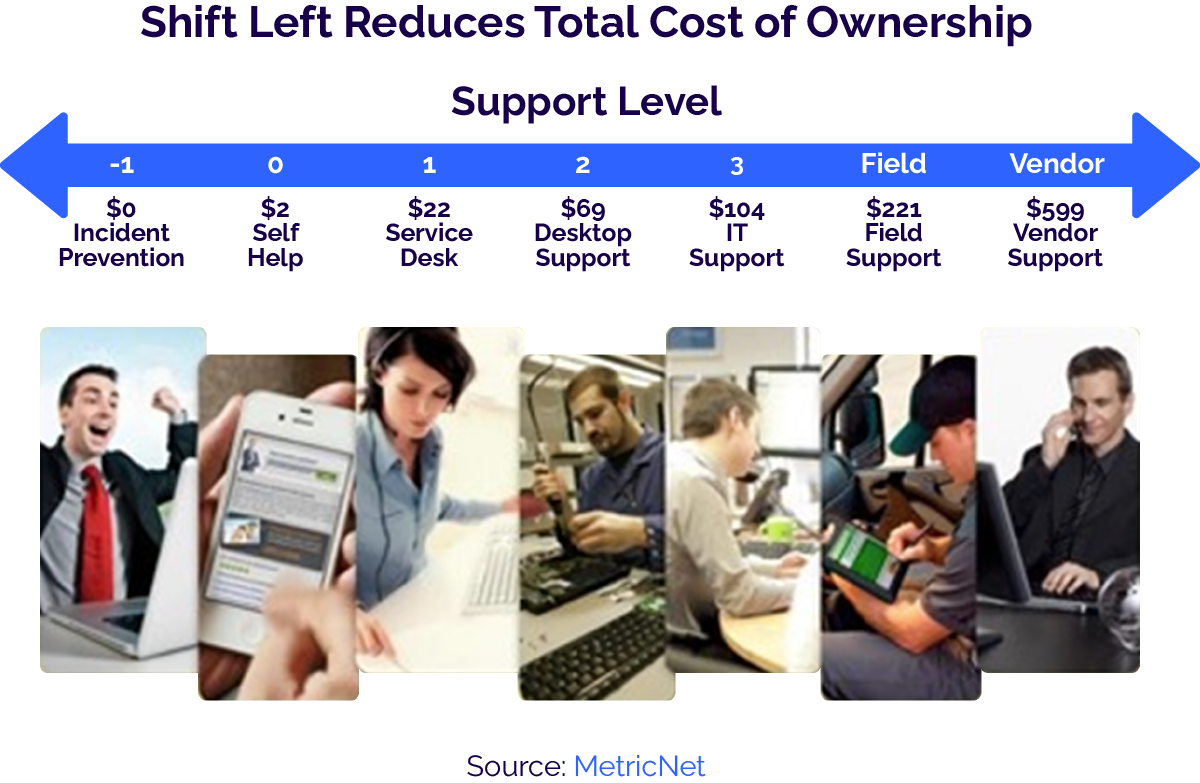If you want to make your Enterprise IT help desk department more efficient and your top-tier support staff more productive, learn how to shift left.
When you shift left, you take the processing, handling, and resolution of tickets from higher support tiers and shift them left one tier or multiple tiers.
The result? You optimize your resources, improve customer satisfaction, and get issues resolved more quickly.
What Shifting Left Looks Like
Picture your support tiers, from Tier 0 (self-serve and automation) all the way to Tier 4 (specialized high-level support).
Now, picture them on a scale from left to right, like you would read a book. When you shift left, you take the processing, handling and resolution of tickets that is presently happening over on the right of the scale (Tiers 3 and 4), and you shift them left to Tier 2, Tier 1 or Tier 0.

For example, your Tier 2 help desk agents could be trained to handle a common issue that gets escalated to Tier 3 desktop support. Some issues could shift even further left to Tier 0 support, which typically involves self-service or automation.
The Goal of Shifting Left
The goal of shifting left is to identify the activities that can be done at the lowest point of contact going through your support process. This frees up your specialized, higher-priced resources to do other things. And you also improve help desk customer satisfaction.
When you take a support task away from a higher-cost application developer, and shift that responsibility left to a help desk role, you give back capacity gains. The higher-cost application developer, instead of being constantly interrupted to fix multiple issues, can now focus on their development work.
(Or they can focus on testing, or bug fixes, or the root causes that are prompting the support calls to begin with. They can then fix those root problems permanently, and eliminate them coming in. This balances IT help desk agent workload.)
The Support Tools Needed to Shift Left
Shifting left means changing the way you offer IT support to your users. It involves a decisive and planned approach that changes how users receive support for certain issues. Shifting left typically involves a shift in tools. Here are a few of them:
Chatbot IT Support
If you can take common support requests and resolve them with chatbots, that’s a shift left. You take issues that presently require human intervention and shift them left to Tier 0, which is self-service. Friendly disclaimer: Chatbots and automation take effort to establish. Correctly identifying issues that qualify for self-service, designing the conversation, testing, training, and deploying require time and resources.
Automation for Common IT Support Processes
Another proven way to shift IT support requests left toward less-expensive solutions is backend automation. Some automation tools, for instance, let you script out password resets, account unlocks, and account creation based on approved ticket types. Whenever a user submits that ticket type, the system fires off scripts behind the scenes that resolve that issue without any human intervention or any involvement of any tier of support.
Essentially, if you can script the resolution, you can automate it. This includes such tasks as:
- starting and stopping a print job
- starting and stopping a batch file
- account unlocks and password resets
If you can script a required action, making that action easy for a user to do with just the click of a button, then use automation to let users fix issues themselves. This means no human intervention, and no money being spent for a human to resolve the issue.
IT Support Knowledge Base
You can promote a shift left with a self-service knowledge base. This option, while helpful, does require a technologically mature user community. Most users prefer to talk to an agent and have somebody walk them through fixing their issue.
To Successfully Shift Left, Look to Your Agents
To shift left, you must first understand how your agents are currently resolving issues.
Examine your help desk in general, starting at the easiest level, and conduct an apples-to-apples comparison of your agents.
If Agent A is resolving 90 out of 100 tickets and Agent B is only resolving 50 of the same type of 100 tickets, what's the difference? It could be something that needs fixing with training.
The difference might be caused by different levels of knowledge, or the two agents using different keywords to search for the same issue in the knowledge base. You can typically improve this situation through training alone.
Now, examine the 10 tickets neither agent could resolve. What knowledge, empowerment and tools would they need to be able to resolve those IT help desk tickets?
- It may be that they’re more or less capable of resolving them, but just weren’t allowed to do so. If so, time to shift that issue left now.
- Maybe they had a good idea of how to solve these issues but weren’t familiar enough with the processes to risk it, in which case a bit of training can easily take care of matters.
- Or, it could be that these unresolved issues were simply beyond the capabilities of your help desk agents. Depending on the volume of these issues, you may need to decide whether your staffing needs to change or if you need to augment your help desk with more specialized agents.
Either way, ask your agents. Whether they’ve been in this industry for 15 years or they've been working with the company for 10 years, they may know things they could be doing that they're not currently doing. Find out what those things are, start sorting it out, and you’ll shift left.
Decide Who is Going to Drive the Shift to Left
You also need to decide who is going to drive the shift to the left. It can come from the top of your organization, or from the bottom.
- A top-down decision involves your leadership team deciding they want to implement a shift left. They gather the required stakeholders in a room and figure out which levels of support are to handle which types of requests.
- A bottom-up approach starts with the help desk at the ticket level. Help desk agents ask themselves, “Which tickets am I sending to the other groups? What things can we realistically expect to manage within, at the help desk level, given our capacity and our staffing without adding too many resources? And which tickets require escalation to higher tiers?
Shifting left pays dividends, the primary one being increased customer satisfaction. Your help desk is the face of IT, so if you can fix something during the first call, and in seven minutes, then you are going to see many more satisfied customers (as opposed to when the ticket takes several days to be reassigned and acknowledged, let alone resolved).
You also get your users back up and productive again, sooner. That increased productivity translates into cost savings to your business. Plus, it improves rapport with the client community, increasing the satisfaction by getting things done quicker.
Finally, shifting left drives value by freeing up your top-tier agents to focus on value-adding activities and not endless troubleshooting.
By the way, if you need help with shifting left, you should consider shifting your Tier 1 support to an outsourced help desk provider.
Learn how by reading our Guide, How To Choose an Enterprise Help Desk IT Support Company.


